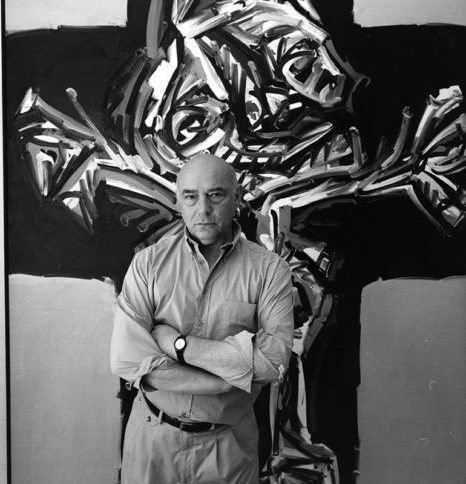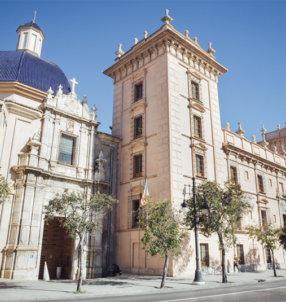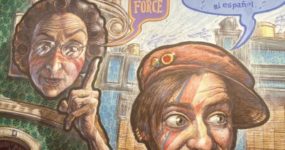Fundación Bancaja will present a major retrospective exhibition of Antonio Saura in a journey through six decades of his artistic work. The exhibition, with nearly 90 works almost entirely from the collection of the Reina Sofía Museum, will be one of the largest retrospectives of the international artist to date. The Bancaja Foundation will show for the first time to the public the work The Three Graces, produced by Saura in 1997 and which has just been incorporated into its art collection.
The Bancaja Foundation will present from 15 September at its headquarters in Valencia a major retrospective exhibition of Antonio Saura, which will cover six decades of his career with works produced between the 1940s and the 1990s. It will be one of the largest retrospectives of the international artist to date. The exhibition, which is being held to coincide with the 25th anniversary of Antonio Saura’s death, is part of the special programme to mark the tenth anniversary of the new Bancaja Foundation.
The exhibition Antonio Saura. Esencial, curated by Fernando Castro Flórez and Lola Durán Úcar, will be made up of around 90 works almost entirely from the artist’s collection in the holdings of the Museo Nacional Centro de Arte Reina Sofía, some of which are unpublished.
The exhibition will allow the Bancaja Foundation to show for the first time to the public the work ‘The Three Graces’, which has just been added to its art collection, reinforcing the international contemporary art section of its art holdings. The canvas is a large format triptych, created by Saura in 1997, a year before his death. The exhibition will be completed with a Multitude, from the Caja Rural de Aragón.
Antonio Saura. Esencial will offer the visitor a narration through Saura’s career, in which his artistic production will be shown in relation to his texts. The exhibition, which will include his pictorial work as well as his drawings and graphic work, will offer a journey through Saura’s language and iconic themes such as ‘Ladies’, ‘Nudes’, ‘Crucifixions’, ‘Crowds’, ‘Heads’ and ‘Imaginary Portraits’.
Antonio Saura (Huesca, 1930-Cuenca, 1998) began to paint and write in Madrid in 1947, while he was recovering from tuberculosis, which kept him immobilised for five years. It was then that his first pictorial research and experiences began. He claims the influence of Arp and Tanguy, but he already distinguishes himself by a personal style. He created numerous drawings and paintings of a dreamlike and surrealist nature.
In 1952 he began his first period in Paris, and between 1954 and 1955 he met Benjamin Péret there and frequented the group of Surrealists, from whom he soon distanced himself and his friend the painter Simon Hantaï. He then used the technique of grattage, adopted a gestural style and a radically abstract, colourist, organic and random style of painting. The first appearances of forms soon became archetypes of the female body or the human figure, two fundamental themes that would occupy the bulk of his work.
From 1956 onwards Saura began his large series, Damas, Desnudos, Autorretratos, Sudarios, Crucifixiones, which he painted both on canvas and on paper. In 1957 he founded the group El Paso in Madrid, which he directed until its dissolution in 1960. He met Michel Tapié and held his first solo exhibition at Rodolphe Stadler’s gallery in Paris, where he exhibited constantly throughout his life. He then limited his palette to blacks, greys and browns. He asserted his own style, independent of the movements and trends of his generation. His work was in the style of Velázquez and Goya. He entered the main museums and from 1959 he devoted himself to a prolific graphic work. In 1967 he settled permanently in Paris, became involved in the opposition to the Franco dictatorship and took part in numerous debates and polemics in the fields of politics, aesthetics and artistic creation.
In 1971 he abandoned painting on canvas, which he took up again in 1979, to devote himself to writing, drawing and painting on paper. From 1977 he began to publish his writings and produced several stage designs for the theatre, as well as for ballet and opera.
Report by ‘24/7 Valencia’ team
Article copyright ‘24/7 Valencia’
‘Antonio Saura. Esencial’
From 15/09/2023 to 28/01/2024
Fundación Bancaja
Plaza de Tetuán, 23 ,Valencia (Valencia)
Email: visitascomentadas@fundacionbancaja.es
Open from Tuesday to Sunday: from 10 a.m. to 2 p.m. and from 4:30 p.m. to 8:30 p.m.
Closed Mondays, except public holidays and the eve of public holidays.
Tickets are purchased at the entrance.
General: 7 euros.
Reduced: 4 euros (pensioners, the unemployed, people with functional diversity, students from 13 to 26 years old and large families).
Free (under 12 years).
Related Post
This site uses Akismet to reduce spam. Learn how your comment data is processed.

























Leave a comment